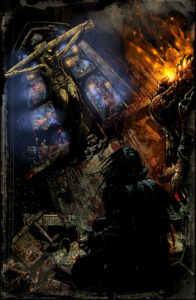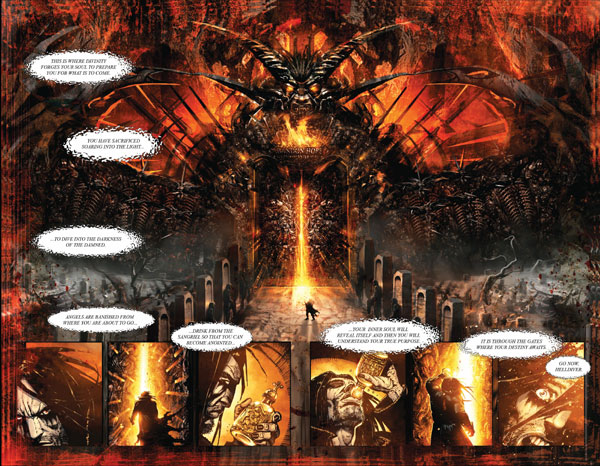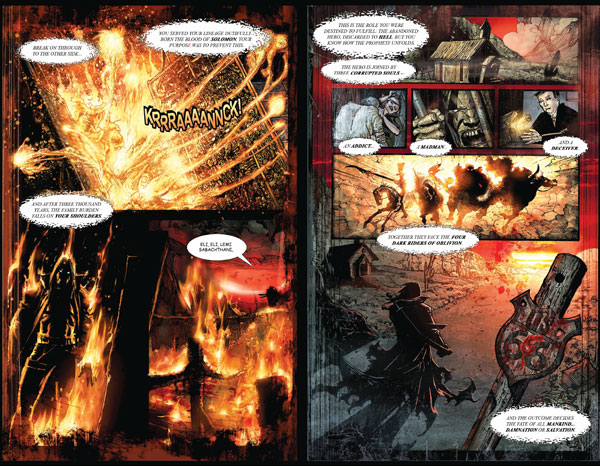 If by some strange chance you’re unfamiliar with the “Heavy Metal” brand, the first thing you should know about Helldiver is that it’s full of gore and nudity, both gratuitous and exaggerated. Let’s put it this way: this isn’t one you’re going to want to read on the bus or subway. Helldiver‘s story also rides steady in the realm of “pure badassery,” so don’t expect any revelatory literary experiences. Do expect: demons, swords, guns, and a High Archon of the Order of Solomon with a black trench coat (stylistically reminiscent of Spawn’s cape) who uses the aforementioned lethal implements to dispatch many of the aforementioned demons. It’s a fun experience, to be sure, as long as you know what you’re getting into.
If by some strange chance you’re unfamiliar with the “Heavy Metal” brand, the first thing you should know about Helldiver is that it’s full of gore and nudity, both gratuitous and exaggerated. Let’s put it this way: this isn’t one you’re going to want to read on the bus or subway. Helldiver‘s story also rides steady in the realm of “pure badassery,” so don’t expect any revelatory literary experiences. Do expect: demons, swords, guns, and a High Archon of the Order of Solomon with a black trench coat (stylistically reminiscent of Spawn’s cape) who uses the aforementioned lethal implements to dispatch many of the aforementioned demons. It’s a fun experience, to be sure, as long as you know what you’re getting into.
Not sure if you’ve noticed this, but the new “thing” around the pop culture scene seems to be angels and demons. (I guess everyone is over Vampires? Here’s hoping, anyway. Maybe they can be cool again in another few years. Damn you Stephanie Meyer!) So the Four Horsemen books are well timed to take advantage of the new trend. Our protagonist, Adam Cahill, is a man who’s given his life to his faith as a High Archon of the secret society The Order of Solomon. The Order has protected the Seven Seals—you know, the biblical ones that, once broken, usher in the end of days—but now they’ve gone missing, and a group known as the Nicolaitans are behind it. The Order calls in Adam, their heavy hitter, to take action. Bloody, bloody action. Eventually, Adam is sent to Hell—sorry, is that a spoiler when we’re talking about a book entitled Helldiver?—where he must track down some misfit companions, damned souls to help him save the world.
Michael Mendheim’s story is very entertaining, with great pacing that moves swiftly from important scenes to set pieces with very little lag time. Mendheim clearly has a knack for Heavy Metal’s particular blend of sex, violence, and incontestable badassery. He weaves the story all over the world and to realms beyond without leaving the reader disoriented, but it’s when we get to Hell that the fun really starts. The realms of Hell are many and personal, peopled by demons in disguise, and the first soul we encounter doesn’t even know she’s dead. From there, things move into a very surreal realm that Adam calls a “patho-reactive plane,” a manifested representation of the soul’s beliefs, fears, and inner demons which she must face. Pretty cool. There are a few off-moments in the writing, like when we get a flashback to something that happened all of six pages previous, or the odd, expository line once Adam gets to Hell, “Your soul can be extinguished, so don’t die again.” This raises the stakes, sure, because otherwise the reader might wonder, “What happens if he dies in Hell? Shouldn’t he just wake up back in Hell like in South Park?” but it still feels a little forced. Luckily these are infrequent, and the majority of the script feels pretty organic.
Simon Bisley’s art is really incredible, and so gritty you won’t believe it until you see it yourself. Unfortunately, this also makes the art occasionally unreadable. Sometimes there is so much going on in a single shot, and the frame composition doesn’t always help you parse out the action very well. These issues are (again only occasionally) exacerbated by strange proportion and foreshortening issues. (The Horsemen website offers a free, seven-page preview. If you’re interested, you would do well to check it out. Especially the gateway to Hell two-page spread, which is a guest painting from Joel Boucquemont.) Those minor issues aside, the art is a pleasure to behold. Chad Fidler’s coloring is vibrant, gorgeous, a great compliment to Bisley’s work, and just excellent all around. Strong color is a huge asset here, considering how many bullets and flames are in the book. There are plenty of frames that will just grab you and force you to examine them down to every detail because they’re just breathtaking. If you’re into totally-metal depictions of Hell, complete with melting faces, crazy demonic monsters, and absurdly-proportioned naked women, you’re going to want to check this one out.
Besides Bisley’s art, the graphical elements of the book are a mixed bag. For instance, the page frames are these lovely, grungy, organic things, they set such a perfect mood against Bisley’s art. On the other hand, the lettering and typographical sensibility is just awful, and this is simply bizarre considering the high production value in every other aspect of the book. It will probably bug some less than others, but to reference the free preview again, look at the voice of God on that same two-page gateway to Hell spread. I’m pretty sure that’s Times New Roman, and the speech bubbles are these ugly blobs that look like built-in Photoshop brushes. Many of the book’s sound effects also look like Microsoft Word WordArt (there are no examples of this in the preview, though). This does not look like the work of a professional letterer, and feels very out of place in an otherwise high quality comic.
Overall, if you can avoid rolling your eyes at some of these admittedly minor flaws, you’ll find an excellent read and a visual pleasure (mostly), but you have to be in the right mood for it. If that right mood strikes, you’re not going to want to miss this book.
(One last thing: Throughout the book, random letters in dialogue are colored red, so if this is some kind of letter jumble, and you can make any sense of it, be sure to let me know.)
[Connor Cleary is an author, video game columnist and critic, and a freelance web-slash-graphic designer. He is a reviewer at GameShark and an occasional opinion and analysis columnist at Gamasutra. His freelance design business is Four Stair Multimedia and Design. You can follow Connor @The_Blue_Key, or at fb/TheBlueKey, or check out his writing archive on tumblr, The Blue Key.]

